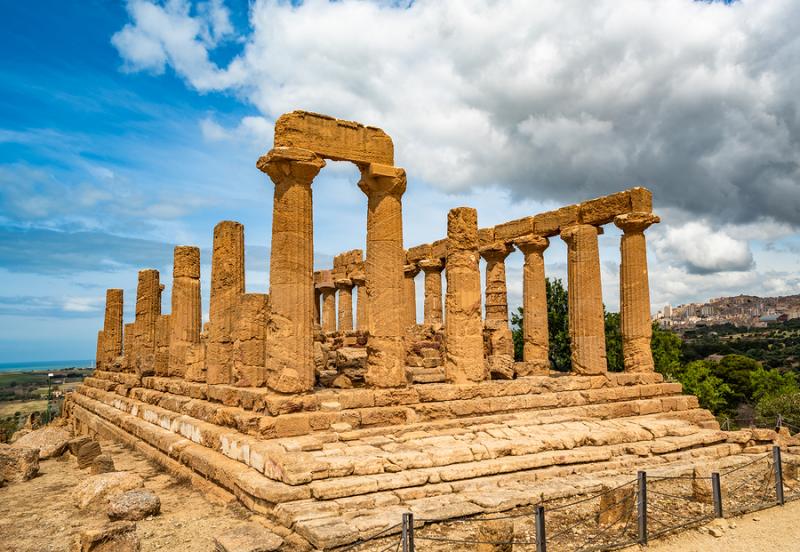Unesco Sites of Italy: Archeological Area of Agrigento
ITA:

The archaeological area of Agrigento, known as the ‘Valley of the Temples,’ is located along the southern coast of Sicily; a Unesco World Heritage site since 1997, it comprises the vast territory of the ancient polis (i.e. a city-state in ancient Greece), from the Rupe Atenea hill to the acropolis of the original ancient city, as well as the sacred hill on which stand the main Doric temples.
It is indeed the magnificent Doric temples that testify to the greatness and supremacy of ancient Agrigento, founded by the Greeks in the 6th century BC. It became one of the leading cities of Magna Grecia during the golden age of ancient Greece, with a population estimated between 200,000 and 800,000 before 406 BC, and a major role in the Mediterranean for trade and for its cultural life.
In the mid-20th century, aerial shots revealed the ancient urban layout that extended throughout the southern hill at the foot of the Atenea cliff and which still partially lies under today’s fields and olive groves.
Agrigento experienced many different rulers during its long history: after being subjected to the Carthaginians, it saw a renaissance when it was conquered by the Romans; but when the Roman Empire started to collapse, it declined and depopulated. Later still, the city became Arab and then Norman, and kept the name given by its last rulers, Girgenti, until 1927, when it took on again the classic name of Agrigento (from the Latin Agrigentum).
Today the original site is a magnificent example of Greek architecture and one of the most significant examples of Doric architecture in the world. Selected excavated areas throw light on the Hellenistic and later Roman town and the burial practices of its early Christian inhabitants.
The Valley includes remains of seven temples, all in Doric style. The Temple of Concordia is ranked amongst the most notable buildings of ancient Greek civilization existing today.
L'area archeologica di Agrigento, conosciuta come la ‘Valle dei Templi’, si trova lungo la costa meridionale della Sicilia; patrimonio mondiale dell'Unesco dal 1997, comprende il vasto territorio dell'antica polis (cioè una città-stato nell'antica Grecia), dalla Rupe Atenea all'acropoli della prima città antica, nonché la collina sacra su cui si trovano i principali templi dorici.
Sono proprio i magnifici templi dorici che testimoniano la grandezza e la supremazia dell'antica Agrigento, fondata dai Greci nel VI secolo a.C. Divenne una delle principali città della Magna Grecia durante l'età d'oro dell'antica Grecia, con una popolazione stimata tra 200.000 e 800.000 abitanti prima del 406 a.C., e un ruolo di primo piano nel Mediterraneo per il commercio e per la sua vita culturale.
A metà del XX° secolo, alcune riprese aeree rivelarono l’antico impianto urbano che si estendeva lungo la collina meridionale ai piedi della Rupe Atenea e che si trova ancora parzialmente sotto i campi e gli uliveti odierni.
Agrigento conobbe molti diversi dominatori durante la sua lunga storia: dopo l’assoggettamento ai Cartaginesi, sperimentò una rinascita quando fu conquistata dai Romani; ma quando l'impero romano iniziò a crollare, declinò e si spopolò. Più tardi, la città divenne araba e poi normanna, e mantenne il nome dato dai suoi ultimi sovrani, Girgenti, fino al 1927, quando riprese il classico nome di Agrigento (dal latino Agrigentum).
Oggi il sito originale è un magnifico esempio di architettura greca e uno dei più significativi esempi di architettura dorica al mondo. Alcune aree scavate forniscono importanti informazioni sulla città ellenistica e poi romana e sulle pratiche di sepoltura dei suoi primi abitanti cristiani.
La valle comprende i resti di sette templi, tutti in stile dorico. Il Tempio della Concordia è considerato tra gli edifici più importanti dell’antica civiltà greca esistenti oggi.











